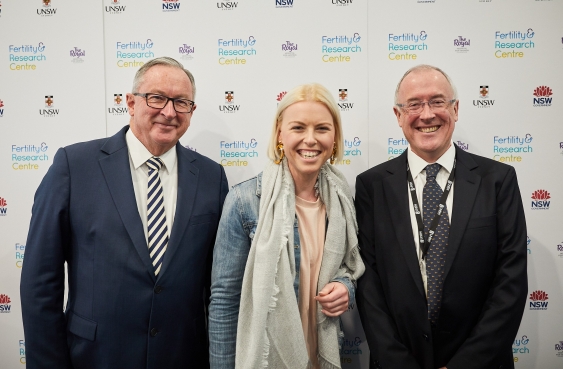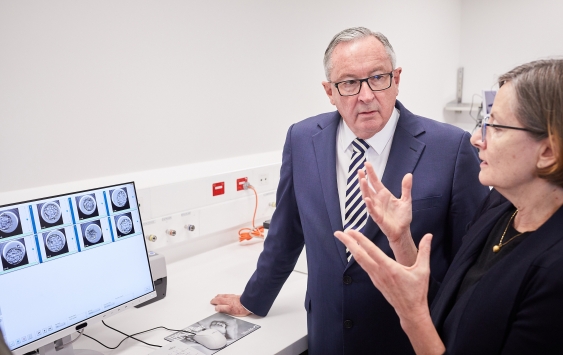A state-of-the-art facility that will offer publicly funded IVF treatment was officially launched on Tuesday by NSW Health Minister Brad Hazzard.
The Fertility & Research Centre, the first of its kind in Australia, is a collaboration between UNSW Sydney and The Royal Hospital for Women.
Led by UNSW's Professor William Ledger, the FRC will offer low-cost IVF treatment and on-site fertility preservation services for young people with cancer and rare genetic diseases. The services will be offered to people across NSW.
“This centre will provide first-class fertility preservation services, giving people with a cancer diagnosis or rare genetic conditions the chance to make their future plans for children a reality,” Mr Hazzard said.
“Combining the latest research with fertility preservation and assisted reproduction services in a public hospital is part of the NSW Government’s $42 million investment in improving access to IVF services.”
The facility will hold an assisted reproduction laboratory and procedure room where a full range of clinical services, including complete reproductive investigations and comprehensive IVF services, will be available to patients in a public hospital setting.

NSW Health Minister Brad Hazzard with Lisa Forrest, who has received treatment at the Fertility and Research Centre and UNSW's Professor of Obstetrics & Gynaecology William Ledger.
Professor of Obstetrics and Gynaecology at UNSW and Director of Reproductive Medicine at the Royal Hospital for Women, Professor Ledger, said the service will be linked with the Kids Cancer Centre at Sydney Children’s Hospital.
“Cancer patients diagnosed at Sydney Children’s or Prince of Wales Hospital can now speak with doctors about fertility preservation the very same day they are told they need chemotherapy,” Professor Ledger said.
The FRC will be a teaching centre at the cutting edge of fertility research bringing together top fertility experts to examine the possibilities of hormone-free IVF and new ways of slowing down the possible decline in egg quality as women age.
Researchers at the FRC are working with UNSW’s Dr Lindsay Wu to find new ways of slowing down the ageing of eggs and find ways to translate those findings into practice.
The team will also work with Professor Robert Gilchrist, a specialist in oocyte and reproductive biology from UNSW’s School of Women’s and Children’s Health, to introduce hormone injection-free IVF treatment and with Dr Kirsty Walters, a senior lecturer in Women’s and Children’s Health, on the impact of polycystic ovary syndrome on infertility.
Professor Ledger said oncofertility services will be available to patients diagnosed with cancer to preserve fertility before undergoing chemotherapy.
“Many young people will encounter cancer in their lives. Chemotherapy and radiotherapy will treat their cancer but will destroy their store of eggs. The answer is to take quick and pre-emptive action by freezing eggs and embryos,” Professor Ledger said.
“We will also offer genetic screening of embryos, helping to eliminate devastating genetic disorders from future generations as well as counselling and psychological support.”
UNSW’s Deputy Vice-Chancellor (Research), Professor Nicholas Fisk, said the FRC was an exemplar of 21st-century collaboration that will bring together clinicians, scientists and interdisciplinary teams in the new Randwick Health Precinct which will better integrate the University with the adjacent Randwick hospitals.

NSW Health Minister Brad Hazzard at the launch of the Fertility and Research Centre.
“I can’t think of an area where you have closer bench to bedside and lab to patient activity than you have in IVF and infertility services,” Professor Fisk said. “Australia has been a leader in IVF, with about one in 25 babies born via IVF. At UNSW we are delighted that fertility services are being extended in the public sector where they can be readily and comprehensively available state-wide.”
“Researchers will examine high powered genetic approaches which will be used to improve pregnancy rates and pre-implantation diagnosis for couples at risk of hundreds of genetic diseases, for which there is unlikely o be any curative treatments in our lifetime,” Professor Fisk said.
“New approaches will be examined into preserving eggs, ovarian tissue, gametes and embryos for younger people with cancer, and reducing the risk of implantation failure and miscarriage in women in their 30s and 40s,” Professor Fisk said.
At Tuesday’s launch, 12-year-old Emily Smethills, who was diagnosed and treated with Ewing's sarcoma at Sydney Children’s Hospital, opened the FRC with Minister Hazzard and Professor Ledger. Ms Smethills was one of the first patients to receive fertility treatment, including tissue preservation, at the new facility.


